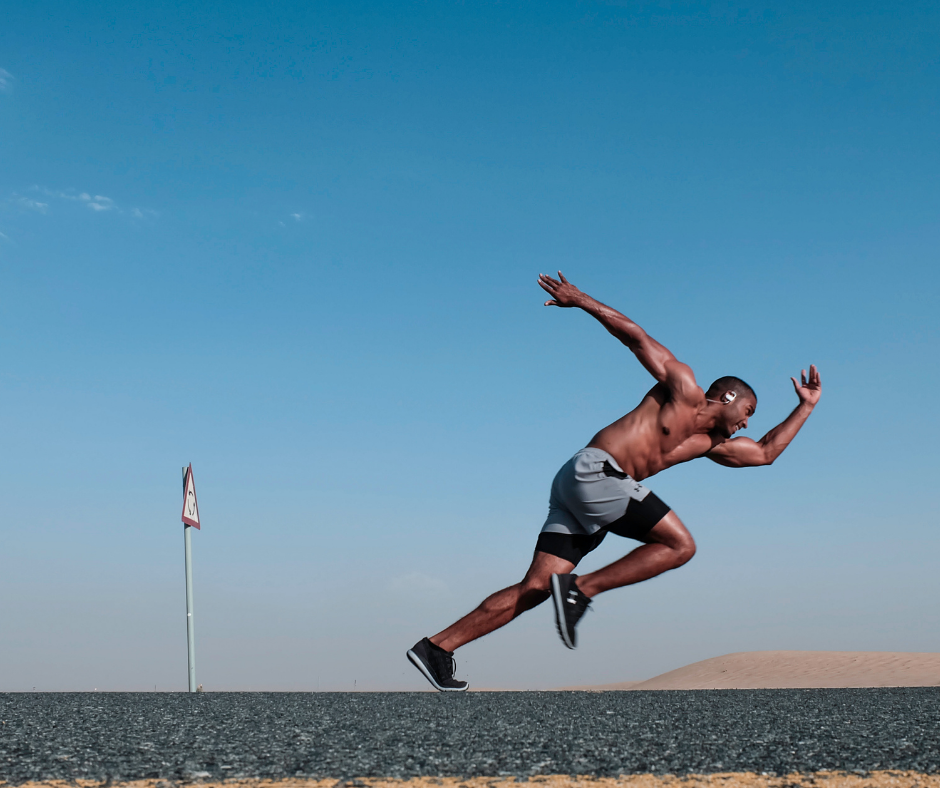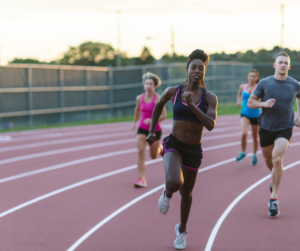I think, if you’re reading this article then you will agree with me that two fundamental goals of runners of all ages and levels are running faster and running farther.
If you’ve been running for a while you’ll know the good ol’ running plateau…
Whether you’re looking to increase your running speed for race day or your own workouts, there are many proven ways that you can build running endurance and learn how to run faster without getting tired and staying injury-free.

Before we cover how to run faster, let’s have a look at the root problem…
8 Reasons Why You’re Running Slow
- You do all your training runs at the same pace.
- You run your easy runs too fast or too hard.
- Your training is inconsistent.
- How much you are training.
- You’re training too much.
- Your nutrition intake is all wrong.
- You don’t have the physical strength to sustain the running.
- You aren’t getting enough good quality sleep.
Let’s dive into these in a bit more detail…
You do all your training runs at the same pace.
Never forget the 80/20 principle, you should do 80% of your training at a low intensity and 20% or less at a high intensity.
The smaller the gap between your easy run intensity and your hard run intensity the more likely you are to plateau.
You run your easy runs too fast or too hard.
The reason why we suggest running your easy runs EASY is that by running too hard your eccentric loading on your muscles is causing a lot of damage.
That damage takes a lot longer to recover, which means you would need to extend your recovery time which will affect the quality of your running session the next day.
By running nice and easy you will still be giving your body the same physiological benefits but ensuring you recover quicker for the next run.
Pro Tip: Slowing your easy runs down improves aerobic capacity.
An improved aerobic capacity means that you will be able to recover faster, and it improves your running economy by allowing you to metabolize fuel better.
Your training is inconsistent.

This is normally regarded as the most important aspect of your training. This is because if you don’t have a consistent training plan then your training will fall apart.
Lack of consistency impacts improvements over time.
A great way to think of consistency is as if it were a financial investment.
The small little bits over time lead to big amounts and that’s the same thing as fitness.
You should aim to stick to your training plan as well as possible.
*Remember that rest is considered a session.
How much you are training.
The more frequently you run, the better your aerobic base becomes. The better your aerobic base, the more your running pace increases.
There is a fine line between training enough and training too much.
You’re training too much.
A lot of people fall into the trap of doing too much volume. What will happen is that you’ll find yourself feeling tired ALL the time.
This is something we should get away from.
We do not improve fitness in every training session. During recovery is where the adaptation occurs.
The only training session you’ll get the most benefit from is the one you recover properly from.
Your nutrition intake is all wrong.

It’s crucial to understand that if you don’t put enough fuel into your body or if you’re putting the wrong fuel into your body then you will compromise your recovery and the amount of energy that is available for you to do the training that you want to do.
You need to eat ENOUGH good quality food (fats, carbohydrates, proteins, vitamins) and they need to be eaten at the correct TIME in relation to exercise.
Find out when the correct time is to eat nutritious food in relation to your exercise in this video:
You don’t have the physical strength to sustain the running.
Strength training is absolutely vital.
When you are doing any exercise, running in particular, you are recruiting muscle fibers that need to contract. If you can’t do that enough, then you won’t get any faster.
It has been proven that strength training can improve your running performance by up to 5%.
If strength training is what you’re after, grab a free-running strength plan here.
You aren’t getting enough good quality sleep.
You need to prioritize getting as much sleep as you can, as consistently as possible.
Life is chaotic and busy. We get that.
Avoid inconsistency by getting one night of 8 hours of sleep a week, and the rest is all over the place. For the rest of the week, you should try to get 30-60min per night more than you normally do and try to get as much as possible as consistently as possible.
A good night’s sleep will help build and repair muscles balance your hormones and improve your overall athletic performance.
In this article we cover the benefits of a good night’s sleep on your running in a lot more detail: Here.
Now that you know why you may be running slow, let’s dive into how to speed right up!
4 Steps To Running Faster
- Recovery
Most people think that you only get the benefits of what you’re doing while you are doing the exercise.

This is false.
You don’t get fitter and faster while you are running, it all happens during the time that you recover.
It’s not about doing more all the time, it’s all about HOW you recover.
By neglecting your recovery time, you will arrive at your next run feeling tired, not fresh, and have a higher chance of getting injured.
How do you know if you’ve recovered enough?
We like to use 3 simple processes:
- Ask yourself if you’re feeling stiff or if you’re feeling pain anywhere?
Muscle soreness is an indication that you haven’t recovered properly.
- Take your resting heart rate every morning after you have emptied your bladder.
That number should stay consistent over time. When it starts to go up then you are not recovered properly.
- Modern wearables.
With modern wearables now, you can use something very useful called heart rate variability. If you are tracking your heart rate variability, particularly while sleeping, over time that allows you to compare if you are recovering well
2. Pacing
This is the number 1 mistake that amateur athletes make…
We’re all guilty of it, if we feel that we’re not smashing ourselves in our training sessions then it’s not good enough.
It is key to slow down and to run in particular our slow/ easy runs & long runs at the correct slow pace to improve our aerobic efficiency.
Why is it so important to run our training runs at the correct pace?
To improve endurance we need to run in the correct “zone”. This refers to the intensity we run at. That’s where the body becomes more efficient (You become a better runner).
This range is very wide though. You can run in the faster end of the range = lots more eccentric stress and load on the body or you can run on the slower end = with much less stress on the body.

Training at the correct pace is so important because when we are running in the correct zone, that essentially is when we are getting all the physiological adaptation that we need.
Essentially, zones are bands of intensity, with zone 1 typically referring to recovery, zone 2 aerobic endurance, zone 3 anaerobic threshold. For endurance training, we are referring to zone 2.
When you’re running within zone 2, you can run towards the top end of that zone (but the closer you get to the top, the more likely you are to move into zone 3, moving away from the intended workout and increasing the physical stress on your muscles.), which is a little bit faster, or the bottom end. When you’re running at the top end of that zone, you’re putting a lot of eccentric stress on your muscles.
You can run at the bottom end of the zone and then there will be less of that load of eccentric contraction and less wear and tear on the body. You’re going to be getting exactly the same benefits as if you were running towards the top end of that zone.
How To Monitor Pacing
A very simple tool that we love at Coach Parry is…
To be able to hold a conversation with the person you are running with or to be able to break out into song.
You should be able to breathe quite easily, have a light sweat at the end of your training run, and feel like you can go a bit further.
We’re not saying all your training runs need to be this easy, just remember the 80/20 rule. The majority of your runs need to be easy so that the ones that need to be hard, can be really hard.
3. Strength Training

You may be sick of hearing this from us but this is going to CHANGE your running!
Strength training helps keep you injury-free.
As we discussed earlier, running is a compounding sport, it places that eccentric strain on your muscles.
Strength training helps build the structures around the joints and helps make the joints stronger, allowing your body to sustain the load from running so much better.
Strength training has massive effects on your running performance.
You will improve your running performance (needing less fuel to run longer distances) by not even running at all.
Strength training doesn’t yield instant improvements, in fact, in the short term, it makes you a little sore and takes you right out of your comfort zone. – This is why so few people do strength training.
When we say strength training, we mean resistance training – pushing your body against any form of resistance.
Any form of resistance training could be bodyweight, weight training, or even resistance bands.
Ideally, you should be doing resistance training once or twice a week, as this is when you will reap the most benefits in your running.
Here at Coach Parry, we’re massive advocates of strength training. We’ve put together this free strength training plan for runners that you can do once a week, at home and with no expensive equipment needed. You can access it by clicking here.
4. Consistency
We’re not talking about consistency in a way that you might think.
You will notice if you look back at your running career that every time you have had a successful race it has come off the back of your most consistent training block.
The consistency we are talking about comes from doing the right stuff day after day, week after week, and month after month.
To achieve this type of consistency, you need to get the first 3 steps correct.
This will allow you to achieve successful training block after successful training block to build on your past successes and improve into the future.
How to run faster without getting tired ->> Here
So, we’ve had a look at pace, consistency, recovery, and strength training… Let’s see if there are any other ways to increase your running speed.
Will Changing Your Running Form To Run Faster Work?
We have all seen those runners who just seem to float and glide along. They seem to have perfect form.
Certain runner forms are more efficient and people who run faster tend to have better running form. BUT, In terms of being able to manipulate and change the running form, that is extremely hard to do.
In terms of having an ideal way of running, that is also very hard to do.
This is because, even at the top end of the sport, two runners that don’t look at all alike (not the same height & build) can’t be expected to squeeze into a specific way of running.
We are all unique and we are all an ongoing experiment.
If you run intelligently, build a program that allows you to train consistently and helps you avoid injury, then your body will find its most efficient way of moving.

The “Ideal” Running Posture
We do know that certain factors will get you the closest you can get to an ideal running posture, like a slightly forward lean, having a straight posture so that you can almost draw a line from your ear to your shoulder to your hips, to your heel that’s pushing off the ground.
For example, if we try to force a bigger, taller runner to move into these positions, particularly on their easier runs, then we will be shifting the stress from perhaps their knees straight down into their calves and Achilles.
The point is that there is going to be stress placed on the body, and depending on how you’ve been running over the years, your body will be adapted to absorb that stress, so if we go and make changes, we have to make the changes REALLY slowly.
Why We Don’t Spend Loads Of Time Getting People To Change Their Posture
Over the years we have watched many … many… many elite athletes in competition and what we have noticed is that when the chips are really down when they are tight and fall under immense pressure. They revert to TYPE.
By type we mean, what their body is best adapted for, what their body was built for, the physics that their very own body has got.
What if you were born with really bad biomechanics and just want to run faster?
Is It Worth Manipulating Your Form To Run Faster?
The next section is often spoken about in whispers and with much trepidation. Should I do track training?
Track training has its place and is nothing to be feared.
Are Speed Sessions On The Track Necessary To Run Fast?
Speed sessions on a track are necessary for the final phases of the preparation, but it’s not really the “thing” that makes you faster.
There is some debate about how much aerobic vs anaerobic is contributed during and 800 meters, but certainly from 1500 meters and up, is very aerobic dominated, and in the market that we deal with, which is 5k’s to 100 milers, then the aerobic component is the most important.
You will only improve using speed work if you sort out that aerobic component first, and that’s why at Coach Parry we are always so hardcore about … Run easy, run easy, run easy!
There are lots of good things about doing track work (once you have built up your aerobic strength), some of them are physiological, some are around coordination and some are around the range of motion.
The ratio between the easy runs and the speed work depends on your level of running.

Dangers To Speed Work
The obvious danger to speed work on a track is the increased risk of injury.
This comes down to the fact that most people when they do get down to the track, they just don’t do it properly.
Anyone can go down and run 400s as fast as they can. But that’s just going to leave you sore, possibly injured, and will compromise your training going forward.
If you are going to head to a track, ensure that you are doing the appropriate type of session at the appropriate intensity and volume.
When Should You Not Run On Track?
If you have just started running, are new to running, haven’t developed your aerobic capacity, or are recovering from an injury then you should avoid the track.
It’s important to remember that if you want to run fast, for a long time then you need to have a highly developed aerobic system and if you develop that aerobic system, what will happen is that you will be able to run faster… And faster… And faster at or just below the threshold.
If you overdevelop your anaerobic system by running too much speed work or by running your easy runs too hard then you will push that threshold down.
That pretty much sums up how you can run faster…
If you’re looking to run a sub 4 hour Marathon then here is your answer: Click here!
Or
If you’re looking to run a sun 45 minute 10K, we’ve got you covered: Here.
What does this all mean for the runners over 50 who want to run faster?
How To Run Faster & Longer As You Get Older
While there is still a notable physiological decline as we get older, the body still shows great aptitude for adaptation if provided with the right stimulus.
If the correct training intensities and volume of training are followed and complemented with good strength training at least twice a week you can run better as you get older.
Making sure you do the correct strength training is important. The good news is we’ve created a free strength training plan for runners that you can download by clicking here.
There is a saying that children are not small adults and so we shouldn’t train them as such, the same should ring true for runners over 50.
Of course, the basic training principles still apply but it is key to manipulate the volume and intensity of the program to run fast as you age.
Save your seat at our next Faster Beyond Fifty Masterclass below!

Join us for a free online presentation of the…
The Faster Beyond 50 Masterclass
…and discover how you can run well (and faster) as you get older, without training more or harder than you currently are, all while avoiding injury.
If it feels like you’re training harder than ever but not running the paces you’d like to be running or if you’re constantly tired, fatigued or running in some sort of pain, then this is specifically for you.




Comments are closed.